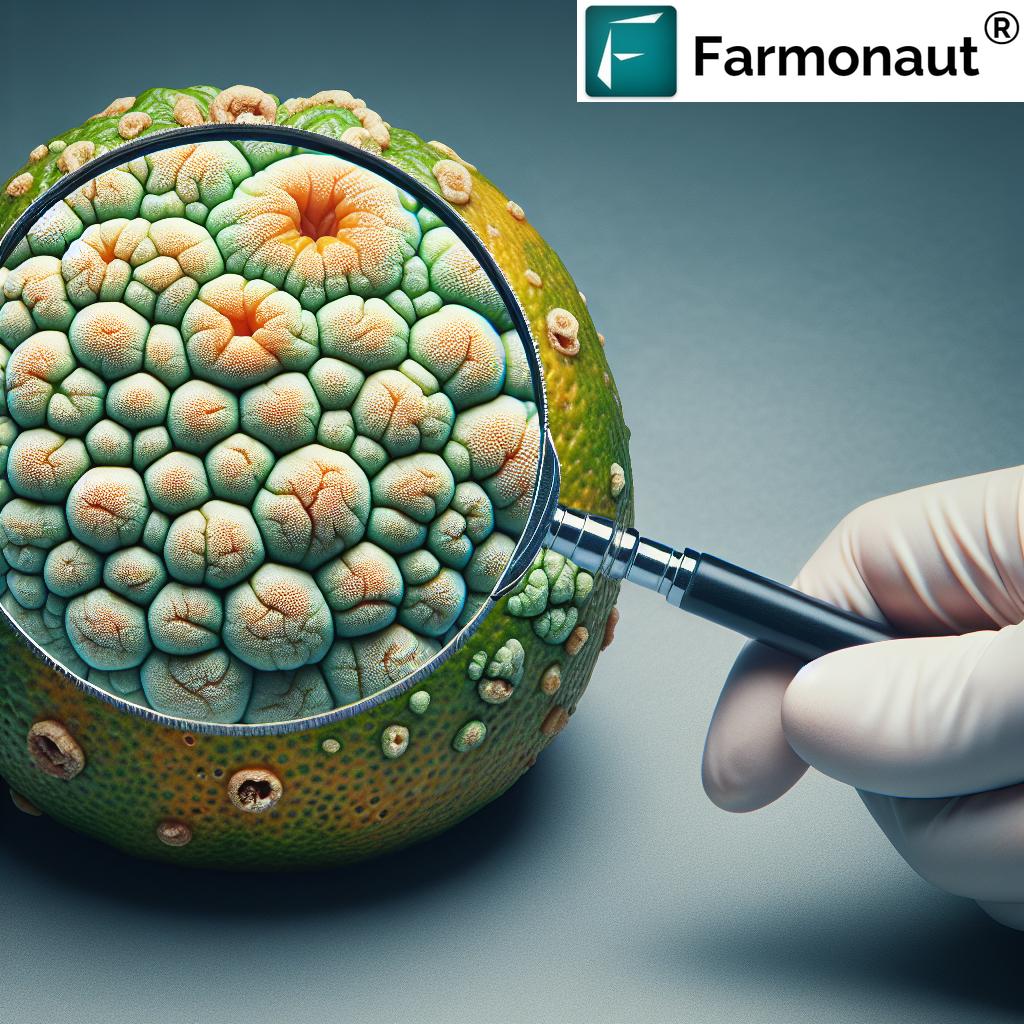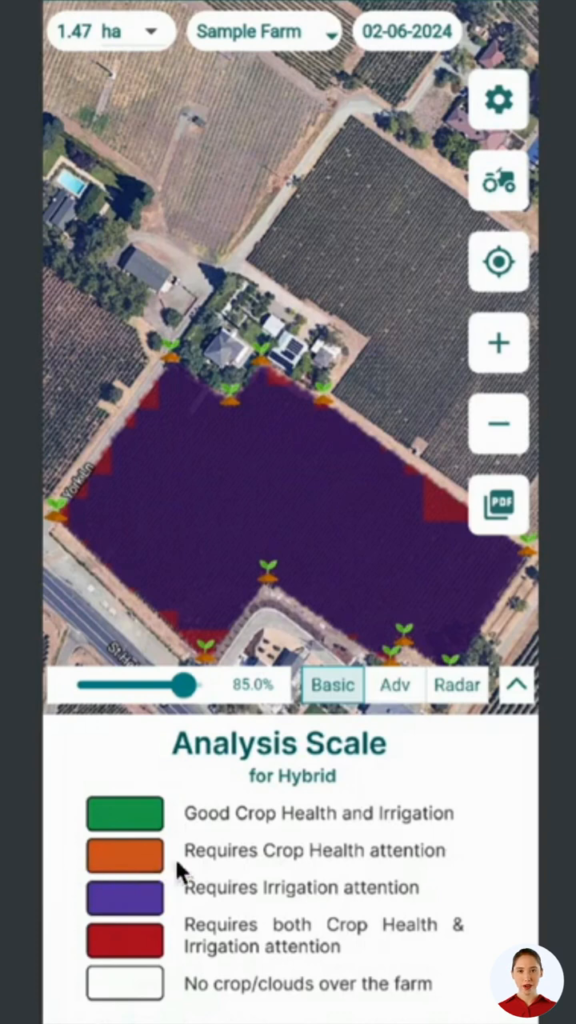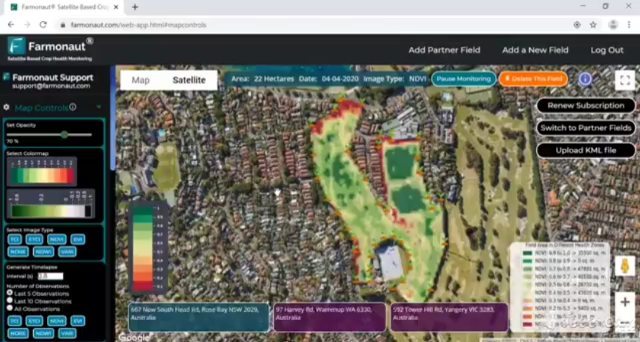
Organic Treatment and Control: Managing Citrus Canker Disease in Humid Weather
At Farmonaut, we understand the challenges faced by citrus growers in managing diseases like citrus canker, especially in humid weather conditions. In this comprehensive guide, we’ll explore the intricacies of citrus canker, its impact on fruit production, and effective organic and conventional treatment methods. We’ll also discuss how our satellite-based technology can revolutionize the way farmers detect and manage this persistent disease.
Understanding Citrus Canker: A Bacterial Menace
Citrus canker is a devastating bacterial disease that affects various citrus fruits, causing significant economic losses for growers worldwide. The disease is caused by the bacterium Xanthomonas axonopodis pv. citri, which thrives in warm and humid environments.
Key characteristics of citrus canker include:
- Visible lesions on leaves, fruits, and stems
- Corky, elevated blisters on infected plant parts
- Reduced fruit quality and premature fruit drop
- Weakening of the infected tree over time
The Role of Weather in Citrus Canker Spread
Weather conditions play a crucial role in the development and spread of citrus canker. Understanding these factors is essential for effective disease management:
- Humidity: High humidity creates an ideal environment for bacterial growth and infection.
- Temperature: Warm temperatures between 20°C and 30°C (68°F to 86°F) favor disease development.
- Rainfall: Rain facilitates the spread of bacteria from infected areas to healthy plant parts.
- Wind: Strong winds can cause microabrasions on plant surfaces, creating entry points for bacteria.
At Farmonaut, our advanced satellite-based weather monitoring system provides real-time data on these critical factors, enabling farmers to anticipate and prepare for high-risk periods. Learn more about our weather API here.
The Infection Process: How Citrus Canker Takes Hold
Understanding the infection process is crucial for developing effective control strategies. Here’s how citrus canker typically spreads and infects trees:
- Entry: The bacteria enter the plant through natural openings like stomata or wounds on leaves, fruits, or stems.
- Colonization: Once inside, the bacteria multiply rapidly in the intercellular spaces of the plant tissue.
- Symptom Development: As the infection progresses, visible lesions begin to form on the plant surface.
- Spread: Bacteria ooze from mature lesions during wet weather, facilitating further spread to nearby plants.
The rapid spread of citrus canker underscores the importance of early detection and prompt action. This is where Farmonaut’s satellite-based monitoring system excels, providing farmers with timely alerts about potential disease outbreaks.
Recognizing Citrus Canker Symptoms
Early identification of citrus canker symptoms is crucial for effective management. Here are the key signs to look out for:
- On Leaves: Small, round lesions with water-soaked margins that eventually turn brown and corky.
- On Fruits: Raised, corky lesions that may have a yellow halo. Severely infected fruits may fall prematurely.
- On Stems and Twigs: Raised, corky lesions that can lead to dieback of affected branches.
- Overall Tree Health: Infected trees may show reduced vigor, defoliation, and decreased fruit production.

Our satellite imaging technology at Farmonaut can detect subtle changes in plant health, often before visible symptoms appear. This early warning system gives farmers a crucial advantage in managing citrus canker.
Organic Treatment Options for Citrus Canker
At Farmonaut, we advocate for sustainable farming practices. Here are some effective organic treatment options for managing citrus canker:
- Copper-based Sprays: Organic copper fungicides can help prevent new infections when applied regularly.
- Biological Control Agents: Beneficial microorganisms can help suppress the growth of the canker-causing bacteria.
- Plant-derived Antimicrobials: Certain plant extracts have shown promise in controlling citrus canker.
- Soil Health Management: Improving soil health can boost the tree’s natural defenses against disease.
Remember, organic treatments often require more frequent application and careful timing for maximum effectiveness. Our satellite monitoring system can help you optimize the timing of these treatments based on weather conditions and plant health status.
Conventional Chemical Control Methods
While we promote organic farming, we understand that some situations may require conventional chemical treatments. Here are some common chemical control methods for citrus canker:
- Copper-based bactericides
- Streptomycin-based antibiotics (where legal)
- Quaternary ammonium compounds for disinfection
It’s important to note that chemical treatments should be used judiciously and in compliance with local regulations. Overuse can lead to environmental issues and the development of resistant bacterial strains.
Integrated Pest Management: A Holistic Approach
At Farmonaut, we believe in an integrated approach to pest and disease management. For citrus canker, this involves:
- Prevention: Using disease-resistant varieties and maintaining proper tree spacing.
- Monitoring: Regular inspections and use of our satellite-based health monitoring system.
- Cultural Practices: Proper pruning, sanitation, and water management.
- Biological Control: Encouraging beneficial microorganisms in the orchard ecosystem.
- Chemical Control: Judicious use of approved pesticides when necessary.
Our AI-powered advisory system, Jeevn AI, can help you develop a customized integrated pest management plan for your orchard. Learn more about Jeevn AI here.
The Role of Weather Monitoring in Citrus Canker Management
Effective citrus canker management requires a deep understanding of weather patterns and their impact on disease development. Here’s how weather monitoring can help:
- Predicting Disease Outbreaks: By tracking humidity, temperature, and rainfall, we can forecast high-risk periods for canker development.
- Optimizing Treatment Timing: Weather data helps determine the best times for applying treatments, ensuring maximum efficacy.
- Irrigation Management: Proper irrigation scheduling based on weather forecasts can help reduce leaf wetness and disease risk.
- Long-term Planning: Historical weather data can inform decisions about orchard layout and variety selection.
Farmonaut’s satellite-based weather monitoring system provides real-time and forecast data, enabling farmers to make informed decisions about citrus canker management. Our system is accessible via web and mobile apps, ensuring you have crucial information at your fingertips.
Download our Android app or get it on iOS to start monitoring your orchard’s weather conditions today.
Farmonaut’s Satellite Technology: Revolutionizing Citrus Canker Detection
Our advanced satellite-based monitoring system offers several advantages over traditional methods in detecting and managing citrus canker:
| Feature | Traditional Methods | Farmonaut Satellite System |
|---|---|---|
| Early Detection | Relies on visual inspection, often detecting disease after symptoms appear | Can detect subtle changes in plant health before visible symptoms, enabling earlier intervention |
| Monitoring Large Areas | Time-consuming and labor-intensive for large orchards | Can monitor vast areas quickly and efficiently, providing a comprehensive view of orchard health |
| Precision in Identifying Infected Trees | May miss early infections or misidentify symptoms | Uses multispectral imaging to accurately identify stressed or infected trees with high precision |
| Cost-effectiveness | Requires significant manual labor and repeated field visits | Provides continuous monitoring at a fraction of the cost of traditional methods |
By leveraging our satellite technology, citrus growers can detect and respond to citrus canker outbreaks faster and more efficiently than ever before.
Case Study: Successful Citrus Canker Management with Farmonaut
While we don’t typically include case studies, we can discuss a hypothetical scenario to illustrate the potential of our technology:
Imagine a 100-hectare citrus orchard in a region prone to citrus canker. By implementing Farmonaut’s satellite monitoring system, the farm manager receives early alerts about potential disease outbreaks based on changes in plant health indices and weather conditions. This early warning allows for targeted inspections and prompt treatment of affected areas, significantly reducing the spread of the disease and minimizing crop losses.
Future Directions in Citrus Canker Management
At Farmonaut, we’re constantly innovating to improve disease management strategies. Some exciting developments on the horizon include:
- AI-powered image analysis for even more accurate disease detection
- Integration of drone technology for high-resolution, on-demand orchard inspections
- Development of predictive models that combine satellite data, weather information, and historical disease patterns
- Exploration of new biological control agents and plant-based treatments for citrus canker
Stay tuned to our platform for the latest updates and innovations in citrus disease management.
FAQs About Citrus Canker and Its Management
- Q: Can citrus canker affect all citrus varieties?
A: Yes, all citrus varieties are susceptible to citrus canker, although some are more resistant than others. - Q: How long can the citrus canker bacteria survive in the environment?
A: The bacteria can survive for several months in plant debris or soil, highlighting the importance of proper sanitation practices. - Q: Are organic treatments as effective as conventional chemicals for controlling citrus canker?
A: Organic treatments can be effective when used as part of an integrated management approach, but they may require more frequent application and careful timing. - Q: How often should I inspect my citrus trees for canker symptoms?
A: Regular inspections, at least weekly during the growing season, are recommended. However, with Farmonaut’s satellite monitoring, you can receive alerts about potential issues between inspections. - Q: Can citrus canker be completely eradicated from an infected orchard?
A: Complete eradication is challenging, especially in areas where the disease is endemic. The focus is usually on management and containment rather than eradication.
Conclusion: Empowering Citrus Growers with Advanced Technology
Managing citrus canker in humid weather conditions is a complex challenge that requires a multifaceted approach. By combining traditional knowledge with cutting-edge technology like Farmonaut’s satellite-based monitoring system, citrus growers can significantly improve their ability to detect, manage, and control this persistent disease.
Our commitment at Farmonaut is to continue developing innovative solutions that make precision agriculture accessible and affordable for farmers worldwide. By leveraging our satellite technology, weather monitoring systems, and AI-powered advisory tools, citrus growers can stay one step ahead of citrus canker and other orchard health issues.
Ready to revolutionize your citrus orchard management? Explore our subscription options below and join the Farmonaut community today.
For more information about our satellite monitoring services, weather API, or to schedule a demo, please visit our website or contact our support team. Together, we can build a more resilient and productive future for citrus farming.













